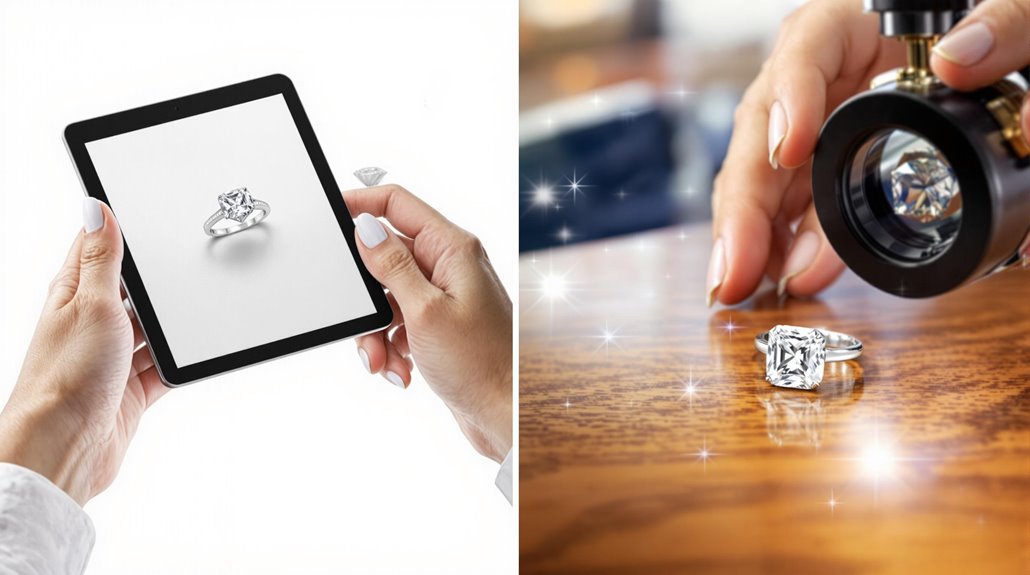Article Contents
- 1 Frequently Asked Questions
- 1.1 How Can I Verify if a Diamond Certificate Is Authentic?
- 1.2 What Happens if My Diamond Gets Damaged During Shipping?
- 1.3 Can I Negotiate Prices When Buying Diamonds Online?
- 1.4 Do Diamonds Look Different Under Store Lighting Versus Natural Light?
- 1.5 Are Lab-Grown Diamonds Priced Differently Online Compared to Physical Stores?
Online diamond shopping offers competitive pricing and broad selection through high-resolution imagery and virtual appointments, whereas traditional retail provides tangible examination and immediate gratification. Digital platforms typically feature lower prices because of reduced overhead costs, thorough buying guides, and ease of comparison shopping. In-store experiences thrive with personalized guidance and the ability to observe light performance firsthand. Grasping the distinct advantages of each approach illuminates the path to an optimal purchasing decision.
When considering the purchase of a diamond, modern consumers face a pivotal decision between the traditional in-store experience and the increasingly popular digital marketplace. The online diamond shopping environment has evolved significantly, offering thorough buying guides and detailed diamond certification information that empowers consumers to make informed decisions. The digital sphere presents an extensive selection of stones, often accompanied by high-resolution imagery and 360-degree videos that showcase each diamond's unique characteristics. Consumers appreciate that online shopping provides lower prices compared to traditional jewelry stores.
The financial advantages of online diamond shopping are particularly noteworthy, as digital retailers typically operate with lower overhead costs, translating to more competitive pricing for consumers. Moreover, the ease of comparing multiple alternatives simultaneously from the comfort of one's home has transformed the diamond shopping experience. Leading retailers like Ritani and VRAI consistently offer the most competitive prices for both mined and lab-grown diamonds. Online platforms excel in providing detailed specifications, allowing buyers to methodically evaluate cut, clarity, color, and carat weight across many choices. Professional virtual appointments are available to provide guidance similar to an in-store experience.
However, the traditional in-store experience maintains distinct advantages that resonate with many diamond enthusiasts. The ability to physically examine a diamond, observing how it catches and reflects light in various settings, offers an irreplaceable tactile experience. In addition, the immediate gratification of leaving a store with one's purchase and the personalized guidance from experienced professionals can provide reassurance during this significant investment. Many online retailers now offer blockchain tracking to ensure diamond authenticity and ethical sourcing.
The digital marketplace does present certain challenges that careful buyers must navigate. The inability to physically inspect diamonds before purchase necessitates additional due diligence, often including third-party appraisals upon receipt. Online shoppers must also contend with potential delivery complications and the risk of fraud, making it crucial to select reputable vendors with established track records.
Traditional retail environments, although offering tangible benefits, come with their own set of limitations. The selection of diamonds is inherently restricted by physical space constraints, and pricing typically reflects higher operational costs. The time investment required for visiting multiple stores can make thorough comparison shopping challenging, particularly in today's fast-paced world.
The future of diamond shopping likely lies in a hybrid approach, where consumers utilize both channels' strengths. Many begin their expedition online, researching and narrowing alternatives through digital platforms, before concluding their purchase in-store, or vice versa.
This evolution in diamond shopping reflects a broader trend in luxury retail, where informed consumers aim to combine the efficiency and breadth of digital commerce with the personalized service and tactile experience of traditional retail environments. The key lies in grasping one's priorities and selecting the shopping method that best aligns with individual preferences and circumstances.
Frequently Asked Questions
How Can I Verify if a Diamond Certificate Is Authentic?
Diamond certification verification involves checking certification numbers through GIA Report Check, examining security features like holograms, and comparing physical characteristics with documented details through established authenticity check methods.
What Happens if My Diamond Gets Damaged During Shipping?
Customers can receive compensation for damaged diamonds through insurance coverage. Reputable sellers offer secure shipping choices with tracking and require signatures, protecting both parties during transit and facilitating claim processes.
Can I Negotiate Prices When Buying Diamonds Online?
Although some assume online prices are fixed, price negotiation is possible with most diamond retailers. Smart shoppers can secure online discounts through promotional codes and direct communication with sellers.
Do Diamonds Look Different Under Store Lighting Versus Natural Light?
Diamond appearance comparison reveals significant differences between store and natural lighting. Diamonds typically show their truest brilliance in natural daylight, whereas store lighting can mask or alter their genuine sparkle.
Are Lab-Grown Diamonds Priced Differently Online Compared to Physical Stores?
Lab-grown diamonds typically show significant price differences between channels. Online retailers offer better discounts because of lower overhead costs, whereas physical stores maintain higher prices in spite of providing personalized shopping experiences.

